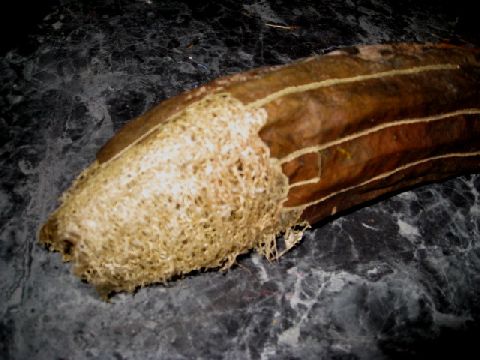On the road… again!
Afghanistan to Zambia
Chronicles of a Footloose Forester
By Dick Pellek
Sponges That Tastes Good
Since ancient times the use of natural sponges for bathing has been a mark of civilization. Imagine: scrubbing your back with the lifeless form of a sea creature that was obtained in the warm waters of the Mediterranean or the Red Sea. Worldwide commerce in sponges from the Mediterranean or the Middle East was proof that tradesmen, sponge divers, and mariners all were involved in supplying a commodity that was not only a vanity but was also recognized as a decadent luxury. Never mind that sponges existed in well-defined ecosystems and had specific requirements that marked them as unique creatures. Despite the fact that neither a nobleman nor a knave really required a Red Sea sponge to bathe, a brisk trade in sponges continued for centuries.

A dried Luffa gourd before it becomes a sponge
After the discovery of ways to manufacture artificial sponges, the sale and utilization of sponges for cleaning dishes increased dramatically. The petroleum-derived sponge was better at soaking up water and other liquids, but lacked the toughness and durability of natural sponges.
One of the most interesting of sponges does not cost the life of a sea creature or depend upon a manufacturing process that utilizes fossil fuels. In fact, this one is a renewable resource. This one is an edible climbing vine. Vines in general can produce useful crops in small, restricted growing areas. One of the most versatile of vines in Haiti is the torchon or luffa, Luffa acutangula, also known as the eponge vegetale (French) or the Dish-cloth gourd (English).
As a vine, it literally grows up the side of a house, provides a pleasant array of leaves that can decorate drab plain surfaces, requires very little soil to get it started, uses sparse, natural rainfall to sustain itself and culminates in a handsome and versatile crop. The tender green and immature gourds of the luffa (up to 20 cm in length and 5-6 cm in diameter) make a tasty ingredient in soups or as a steamed vegetable, but the mature gourd is an even more interesting specimen. The luffa is a double-duty vegetable sponge (up to 40 cm in length and 7-8 cm in diameter). On the other hand, it makes a superior sponge for washing dishes in the kitchen and scrubbing of backs in the bathroom. Because it is stiff yet gentle to the skin, it also can be used as a back scratcher, or massaging the back of someone with whom you are intimate enough to bring up the subject. It also lasts a long time.
These yuppy sponges used to bring about $3.50 each in the marketplace. A few seeds can grow into a network that produces dozens of gourds. At our house in Port-au-Prince, Haiti a few seeds in the ground eventually climbed four meters up the side of the house; a pair of stems twined their way 23 meters around the patio guard rail, and added to our privacy from the outside, even as we enjoyed watching them grow from the inside. In the end, we ate about two dozen tender ones and harvested a dozen more as dried sponges. One of the larger sponges contained 360 seeds, so we had plenty to start the process all over again and enough to share with friends.